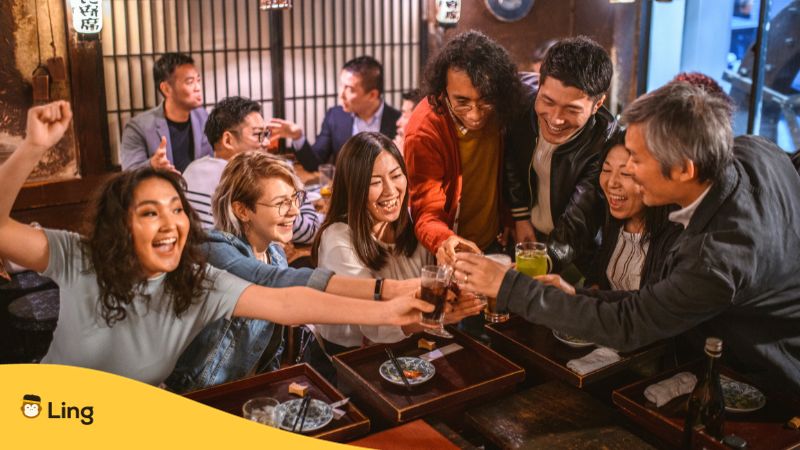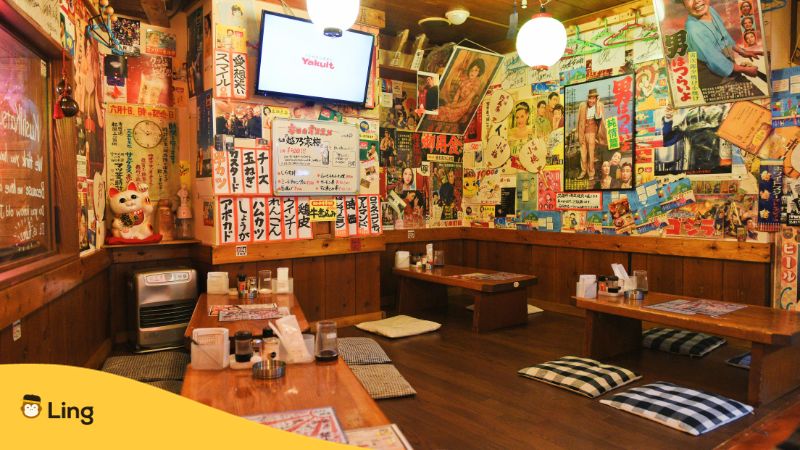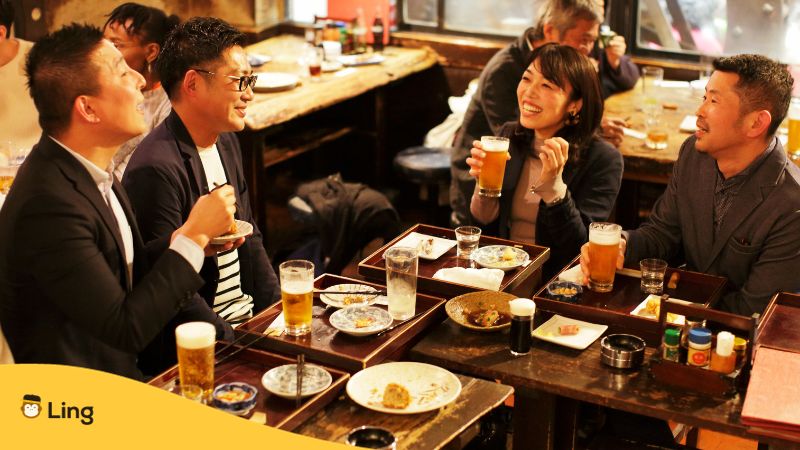Wondering what to do after Tokyo after-work hours? There’s a reason why Izakaya in Japan is a top suggestion on Google!
In this country, heading straight to the bar after a long workday is basically a national pastime. And no place draws bigger crowds than the iconic izakayas (居酒屋)- Japan’s take on casual gastropubs slinging drinks and mad snacks. One look at the red lanterns and local brews flowing inside these watering holes, and you’ll get why salarymen (サラリーマン or sararīman) band together at their favorite spot for booze-filled nomikai (飲み会) parties.
The vibe inside? Think casual tapas plates perfect for sharing + nonstop sake, beer, and shochu. Oh, and the constant chatter between office mates letting off steam over yakitori skewers and draft brews.
But for first-timers unfamiliar with the Japanese language or food customs though, stepping into an izakaya can feel totally intimidating. Between the funky dishes and customs that diverge from your typical Western bar, these places have earned a rep for being radically Japanese spaces.
Should you brave it anyway?
Absolutely!
Learning the culture is a must for visitors who want an authentic experience – and honestly, you’ll have too much fun mingling with the regulars to even feel out of place.
This guide will equip you with everything you need to not just survive, but THRIVE during an izakaya night out in Japan. We’ll cover how to spot an izakaya, izakaya etiquette basics, what dishes to order, and tips on blending right in with the local regulars. With the right game plan, your next party in an izakaya could be your most memorable food and drink experience in Japan yet! So let’s get started!
Table Of Contents
What Is An Izakaya In Japan?
An izakaya (居酒屋) at its core is a Japanese gastropub – a casual, laid-back venue serving drinks and an array of small plates intended for sharing. While superficially izakayas may seem like Japanese bars, they have some distinct differences.
The origins of the izakaya date back over 200 years to sake shops selling alcohol alongside small snacks that complemented the drinks. These evolved into dedicated izakaya establishments that became cultural hubs for people to relax and bond over food and drink after work.
Unlike Western bars that usually have table service, izakayas have a more bustling atmosphere where patrons sit elbow-to-elbow around long communal tables, placing orders and sharing dishes with friends, family, or even fellow patrons. Many izakayas also serve a wide range of Japanese alcohol like sake, shochu, and beer, representing a diversity of Japanese craftsmanship.
The ambiance strikes a balance between lively chatter with the gentle warmth of the glowing lanterns. Izakayas are frequented by young and old, men and women, sararīmen relieving weekday stress and families catching up on the weekends. Dining there is seen as almost therapeutic – lifting one’s mood through delicious comfort food in good company.

Common Izakaya Food
The food at an izakaya is just as much of an attraction as the drinks and ambiance. Izakayas showcase an array of small plates called otōshi (お通し) that are made for sharing. The portions are usually smaller compared to main dishes at full-service restaurants, allowing patrons to sample a variety of items.
| Dish | Japanese | Description |
|---|---|---|
| Yakitori | 焼き鳥 | Grilled chicken skewers with various sauces. |
| Kushikatsu | 串カツ | Deep-fried skewered meat, vegetables, and seafood in crispy batter. |
| Gyoza | 餃子 | Pan-fried or steamed pork and vegetable dumplings. |
| Agedashi Tofu | 揚げ出し豆腐 | Silky fried tofu in dashi broth with seaweed. |
| Takoyaki | たこ焼き | Octopus-filled batter balls, with sauces and mayo. |
| Okonomiyaki | お好み焼き | Savory cabbage pancakes with meat/seafood, sauce, and mayo. |
| Karaage | 唐揚げ | Crispy fried chicken with garlic, ginger, and soy sauce. |
| Edamame | 枝豆 | Boiled, salted green soybeans, a beer snack. |
Common Izakaya Drinks
No izakaya experience is complete without ordering some beer. Popular Japanese beer brands like Asahi, Kirin, and Sapporo flow freely from taps across izakayas nationwide. They are easy to drink all night with the typical light, crisp taste profile. Japan puts its own spin on beer by offering brews like ichiban shibori, a first-press premium beer with more flavor complexity, or beers infused with fruits like yuzu.
For something stronger, be sure to sample Japanese whiskey highballs, a simple yet satisfying cocktail combining whiskey with soda water over ice. Or try a glass of umeshu, a sweet plum wine that makes good use of fresh plums and shochu liquor. When it comes to sake, warm or chilled, the options abound showcasing diverse rice varietals and regions. Share a bottle of namazake for a luxurious unpasteurized first-press taste.
While izakayas traditionally focus on sake, shochu, and beer, many also serve cocktails, whiskey, wine, and soft drinks. Don’t hesitate to ask your server for recommendations! The Japanese do not have a culture of drinking heavily or getting overly intoxicated. Focus instead on trying new things and appreciating the drinks as you would a fine wine!

Finding An Izakaya
Izakayas come in all shapes and sizes, from tiny hole-in-the-wall spaces to expansive dining complexes spread over multiple floors. Decor and seating arrangements can vary greatly too. Some have a casual vibe with shared tables and counter-seats for solo diners. Others cultivate a more traditional atmosphere with private booths and cushions on tatami mat floors where patrons remove their shoes.
At the counter, keep an eye out for dish displays and seasonal decorations, signaling an izakaya entrance. Many also advertise special deals like all-you-can-drink options known as nomihoudai. These allow paying a flat fee for unlimited alcoholic drinks during set time periods, usually 90 minutes to 2 hours. Nomihoudai deals range from ¥1000 to ¥2000 depending on the izakaya’s offerings, with higher-end venues allowing unlimited drinks of beer, sake, shochu, and cocktails.
- Ginza Toriko, Ginza – Lively counter seating with sushi and small plates in the heart of the glamorous Ginza district. ($$-$$$)
- Shinsuke Izakaya, Ueno – Specializes in seafood alongside sake in a warm, woody setting under Ueno Station. ($$)
- Ebisu Yokocho alley, Ebisu – Narrow street crammed with tiny standing-only izakayas selling cheap drinks and snacks. ($)
- Andy’s Shin Hinomoto, Yurakucho – Retro shop spanning over 6 decades serving classic working-man dishes and drinks. ($-$$)
- Gonpachi Nishi Azabu, Roppongi – Inspired by the animated film Kill Bill, this grand complex imitates an Edo period village. ($$$$)
- Uoshin Nogizaka, Akasaka – Sophisticated subterranean izakaya adorned in traditional decor and specialty cocktails. ($$$)

Japanese Izakaya Etiquette
Stepping into an izakaya for the first time brings unfamiliar customs and manners to navigate for newcomers. Be prepared to hear enthusiastic welcomes from staff and patrons alike. Shop owners shout a greeting “irasshaimase“(いらっしゃいませ)! happy to see a new customer enter their establishment. This is your cue to respond with “Shitsurei shimasu” (失礼します), meaning “excuse my rudeness” for interrupting their hospitality.
While language barriers or intimidating menus already heighten the uncertainty for tourists, knowing some basic izakaya etiquette helps ensure an enjoyable experience. In this part, let’s get to know some of the typical izakaya protocols according to the locals.
Most izakayas have a communal atmosphere with shared tables, so be prepared to engage with rowdy regulars or chatty natives curious about foreign visitors. Locals are usually very welcoming, so don’t hesitate to ask questions or sampling suggestions even if there is a language gap.
Unless entering a private dining room, seating works on a first-come, first-served basis. Scope out the busiest section full of salarymen and food that looks appealing. While solo diners will have no issue grabbing counter spots, larger groups should notify staff beforehand for a table reservation if possible.
Ordering food can seem overwhelming given the massive menus, usually only in Japanese. Feel free to simply point or gesture at other tables for what you want to eat. Asking for an “omakase course” leaves it to the chef’s choice of their top izakaya offerings. Most staff can produce English menus or recommend popular picks if struggling.
When it comes to paying, get the server’s attention, or they will let you chill until you ask for the check yourself. Cash continues to be the preferred method, but most urban izakayas now accept credit cards. Also, please remember that there is no customary tipping! Leave your coins, and the locals will be running after you to return them!
Japanese Phrases For An Epic Izakaya Experience
Arming yourself with just a few key izakaya-related Japanese phrases helps overcome language barriers and enhances interactions with locals. Here are some to commit to memory:
- Irasshaimase! (いらっしゃいませー) – Welcome! (When entering an izakaya)
- Shitsurei shimasu (失礼します) – Excuse me (Response to irasshaimase welcome)
- Sumimasen (すみません) – Sorry, excuse me (Flagging down staff)
- Omakase onegaishimasu (お任せお願いします) – We’ll leave it up to you (Requesting chef’s choice)
- Kanpai! (乾杯!) – Cheers! (Toasting drinks)
- Oishii! (美味しいぃ!) – Delicious! (Complimenting good food)
- Okanjou onegaishimasu (お勘定お願いします) – Can we please have the check?
- Arigatou gozaimashita (有難うございました) – Thank you (When leaving)
Of course, locals appreciate any effort to speak Japanese. But don’t worry if you can’t master these words. The Japanese graciously accommodate foreign guests. With some pointing, creative gestures, laughs, and smiles, enjoying an epic izakaya night is universally achievable!
Ready To Step Into An Izakaya?
From the sizzling yakitori chicken skewers and bubbling fried foods to the enthusiastic shouts of “irasshaimase!”, izakayas certainly dish up the full spectrum of Japanese experiences under one roof. Hopefully, this beginner’s guide has provided confidence to plunge headfirst into the izakaya experience anytime your Japan travels provide the chance.
But before anything else… remember to brush up your language abilities with the Ling app! Ling is a handy educational app that helps you make fun conversations in different languages. Whether you’re trying to learn Japanese or planning to master Tagalog or Thai, this all-in-one platform has it all! Download it today and start learning a new language the right way.



































































